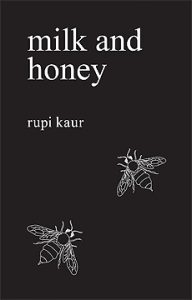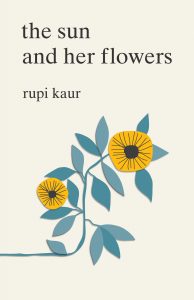The Delegitimization of Rupi Kaur
Kyle Labe//Blog Writer
It’s nearly impossible not to come across Rupi Kaur nowadays. She has gone from humble Tumblr origins to the top of the New York Times bestsellers list. Search the Milk and Honey tag on any social media, and one will find various palettes, posing the contour-sketch cover over muted filters, paired with potted plants, candles, or coffee mugs. Her deeply personal poetry has become an Instagram staple, and her themes of femininity, trauma, healing, sex, and more have resonated with youth across the nation. Her debut collection has sold over 1.5 million copies. The Toronto-based poet has brought new meaning to being a celebrity author, having over 1.7 million followers on Instagram, and even being hailed the “voice of her generation.”

Kaur’s 2015 debut, Milk and Honey, is split into four chapters: “the hurting,” “the loving,” “the breaking,” and “the healing.” Her minimalist poems are told in free verse, and chronicle racial and female identity, gender divide, abuse, and survival, among other topics. Most are paired with sketches drawn by Kaur herself, and she has been acclaimed for her live performances. Her latest collection, The Sun and Her Flowers, was released this past month, and is modeled nearly identically. The black-and-white aesthetic of Milk and Honey has switched to one of more color in The Sun and Her Flowers, and the latter is split into five chapters: “wilting,” “falling,” “rooting,” “rising,” and “blooming.” It was written post-election, and deals with more worldly themes of personal and collective liberation, community, and hope. Kaur’s prose has become more refined, and her poetry is increasingly self-aware, intricate, and structured in The Sun. Nonetheless, her overall style has not fluctuated. Her free verse is still on full display, and excerpts are just as accessible for social media posts.
It’s Kaur’s accessibility that makes her someone special. Kaur turns poetry accessible. Her short, sweet poems create a perfect prototype to take over social networking. They’re easy to read and easy to consume, and from a place where most adolescents are introduced to poetry through long-winded stanzas from the nineteenth century, it introduces them to the world of poetry and provides a medium more identifiable to the masses. With the rise of these so-called “Insta poets,” the market has found an increase in sales, with last year being the highest it’s ever been. It’s new, and it’s fresh, and that means it’s susceptible to criticism. And Kaur, undoubtedly the most famous of “Insta poets,” is at the end of it.

Kaur can’t seem to secure her place in the literary world. She has inspired think pieces galore, with some blaming her of plagiarism, and many commenting of poor writing. But this is nothing new. Kaur writes poetry that appeals specifically to a young female demographic, and our culture has a tendency to downplay, patronize, and ultimately dismiss feminine expression. It happened when Taylor Swift first broke out into the scene with her laments on failed relationships. It still occurs when discussing Sylvia Plath’s legacy, and her lure with adolescent minds. It’s an unfortunate reality that female minds—notably when artistic expression comes into play—are never taken as seriously as their male counterparts. Kaur is just the latest victim of a totem pole of female artists who never garnered the appropriate recognition.
Viewing young adult literature as too “juvenile” to be considered literary is highly antiquated. Many have broken this trope: from Judy Blume, to Laurie Halse Anderson, to Stephen Chbosky, to S.E. Hinton; however, they’ve all met with their fair share of controversy, and have taken years to finally be taken seriously. But Kaur is a voice unlike these. She, herself, is a young woman of color writing commentary on identifying as just that. She doesn’t look like her contemporaries: she was born in India to a Sikh family. She doesn’t fit the mold of the white authors around her. Trying to raise a voice to those like her, Kaur is doing something rarely seen. She is being heard in the mainstream, forcing discourse not only on poetry, but on racial and gender divide as well. The delegitimization of her poetry, in a field that is known for its versatility and fluidity, is both problematic and closed-minded.
It comes down simply to the nature of language. Artistic expression is open to many definitions, and language can be toyed, experimented, and messed with however a poet chooses. That’s because literature is fluid. Throughout the course of history, what is literary has been known to constantly alter. There has been era upon era labeled to reflect this notion. Just because Kaur creates poetry nonstandard to what has been seen before, and because her enjambment may not be as crafted as Keats or Byron does not mean it isn’t resonating with audiences. Because her poetry is perfectly styled for an Instagram aesthetic does not mean it’s any less respectable. Times change, and poetry must as well. Art is just as much a result of its audience as it is the artist, and Kaur has found her audience.

1. “You might not have been my first love but you were the love that made all the other love irrelevant”.
2. “How you love yourself is how you teach others to love you”.
3. “I din’t leave because I stopped loving you I left because the longer I stayed the less i loved myself”. Quotes to motivate you by Rupi Kaur.